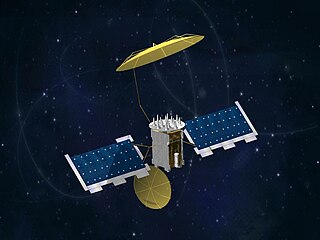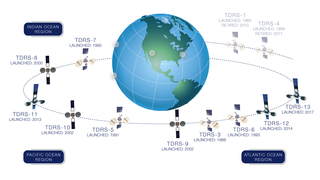Syncom started as a 1961 NASA program for active geosynchronous communication satellites, all of which were developed and manufactured by the Space and Communications division of Hughes Aircraft Company. Syncom 2, launched in 1963, was the world's first geosynchronous communications satellite. Syncom 3, launched in 1964, was the world's first geostationary satellite.

SSL, formerly Space Systems/Loral, LLC (SS/L), of Palo Alto, California, is a wholly owned manufacturing subsidiary of Maxar Technologies.

Sea Launch was a multinational—Norway, Russia, Ukraine, United States—spacecraft launch company founded in 1995 that provided orbital launch services from 1999 to 2014. The company used a mobile maritime launch platform for equatorial launches of commercial payloads on specialized Zenit-3SL rockets from a former mobile/floating oil drilling rig renamed Odyssey.

Milstar is a constellation of military communications satellites in geosynchronous orbit, which are operated by the United States Space Force, and provide secure and jam-resistant worldwide communications to meet the requirements of the Armed Forces of the United States. Six spacecraft were launched between 1994 and 2003, of which only five were operational after launch; the third launch failed, both damaging the satellite and leaving it in an unusable orbit.
The Boeing Satellite Development Center is a major business unit of Boeing Defense, Space & Security. It brought together Boeing satellite operations with that of GM Hughes Electronics' Space and Communications division in El Segundo, California.

The Mobile User Objective System (MUOS) is a United States Space Force narrowband military communications satellite system that supports a worldwide, multi-service population of users in the ultra high frequency (UHF) band. The system provides increased communications capabilities to newer, smaller terminals while still supporting interoperability with legacy terminals. MUOS is designed to support users who require greater mobility, higher bit rates and improved operational availability. The MUOS was declared fully operational for use in 2019.
Thuraya is a United Arab Emirates-based regional mobile-satellite service (MSS) provider. The company operates two geosynchronous satellites and provides telecommunications coverage in more than 161 countries in Europe, the Middle East, North, Central and East Africa, Asia and Australia. Thuraya's L-band network delivers voice and data services.

A tracking and data relay satellite (TDRS) is a type of communications satellite that forms part of the Tracking and Data Relay Satellite System (TDRSS) used by NASA and other United States government agencies for communications to and from independent "User Platforms" such as satellites, balloons, aircraft, the International Space Station, and remote bases like the Amundsen-Scott South Pole Station. This system was designed to replace an existing worldwide network of ground stations that had supported all of NASA's crewed flight missions and uncrewed satellites in low-Earth orbits. The primary system design goal was to increase the amount of time that these spacecraft were in communication with the ground and improve the amount of data that could be transferred. These TDRSS satellites are all designed and built to be launched to and function in geosynchronous orbit, 35,786 km (22,236 mi) above the surface of the Earth.
SkyTerra (SKYT), formerly Mobile Satellite Ventures, was a Reston, Virginia company that developed telecommunications systems that integrate satellite and terrestrial radio communication technologies into one system. In March 2010, the company was acquired by Harbinger Capital Partners and under the leadership of CEO Sanjiv Ahuja became part of a new company called LightSquared. The company placed its first satellite, SkyTerra-1, in orbit on November 14, 2010. LightSquared has since then went bankrupt and emerged from bankruptcy as Ligado Networks.
JSAT Corporation (JSAT) was the first private Japanese satellite operator, which owned the JSAT satellites, as well as operated and partially owned the N-Star with NTT DoCoMo. Its origins can be traced to the funding of Japan Communications Satellite Company (JCSAT) and Satellite Japan Corporation in 1985. Both companies merged into Japan Satellite Systems Inc. in 1993. In 2000 the company was renamed as JSAT Corporation and was listed in the First Section of the Tokyo Stock Exchange. On September 1, 2008, the company was merged into the SKY Perfect JSAT Group.
Marisat satellites were the first maritime telecommunications satellites and were designed to provide dependable telecommunications for commercial shipping and the U.S. Navy from stable geosynchronous orbital locations over the three major ocean regions. The three Marisat satellites, F1, F2, and F3, were built by Hughes Aircraft Corporation (HAC) for COMSAT Corporation starting in 1973. The satellites were designed to provide maritime telecommunications services in three large ocean areas, the Atlantic Ocean, the Pacific Ocean, and the Indian Ocean, and were located at 72.5° East longitude, 176.5° E, and 345° E in the geosynchronous orbital arc. The three-satellite Marisat system served as the initial INMARSAT constellation.
TerreStar-1 is an American communications satellite which was operated by TerreStar Corporation. It was constructed by Space Systems/Loral, based on the LS-1300S bus, and carries E/F band transponders which will be used to provide mobile communications to North America. The signals are transmitted by an 18-metre (59 ft) reflector on the satellite. It had a launch mass of 6,910 kilograms (15,230 lb), making it the second most massive single satellite launched into a geosynchronous transfer orbit, and the second largest commercial communications satellite ever built. Its record as the most massive communication satellite was surpassed by Telstar 19V launched on Falcon 9 on July 21, 2018, with a mass of 7,076 kilograms (15,600 lb).
Orion 3 was an American spacecraft which was intended for use by Orion Network Systems, as a geostationary communications satellite. It was to have been positioned in geostationary orbit at a longitude of 139° East, from where it was to have provided communications services to Asia and Oceania. Due to a malfunction during launch, it was instead delivered to a useless low Earth orbit.

TDRS-9, known before launch as TDRS-I, was an American communications satellite which was operated by NASA as part of the Tracking and Data Relay Satellite System. It was constructed by the Boeing Satellite Development Center, formerly Hughes Space and Communications, and was based on the BSS-601 satellite bus. It was the second Advanced TDRS, or second-generation Tracking and Data Relay Satellite, to be launched.

GOES-4, known as GOES-D before becoming operational, was a geostationary weather satellite which was operated by the United States National Oceanic and Atmospheric Administration as part of the Geostationary Operational Environmental Satellite system. Launched in 1980, it was used for weather forecasting in the United States, and later in Europe. Following its retirement it became the first satellite to be sent into a graveyard orbit.

ESSA-9, also known as TOS-G, was a meteorological satellite. Its name was derived from that of its oversight agency, the Environmental Science Services Administration (ESSA). ESSA-9 replaced the ESSA-7 satellite.

USA-204, or Wideband Global SATCOM 2 (WGS-2) is a United States military communications satellite which is operated by the United States Air Force as part of the Wideband Global SATCOM programme. Launched in 2009, it was the second WGS satellite to reach orbit, and operates in geostationary orbit at a longitude of 60° East.
The JSAT constellation is a communication and broadcasting satellite constellation formerly operated by JSAT Corporation and currently by SKY Perfect JSAT Group. It has become the most important commercial constellation in Japan, and fifth in the world. It has practically amalgamated all private satellite operators in Japan, with only B-SAT left as a local competitor.
JCSAT-4 was known as JCSAT-R until it was sold to INTELSAT in 2009. It is a geostationary communications satellite designed and manufactured by Hughes on the HS-601 satellite bus. It was originally ordered by JSAT Corporation, which later merged into the SKY Perfect JSAT Group. It has a mixed Ku-band and C-band payload and was used as an on orbit spare.
Marisat 2 is a communications satellite operated by COMSAT. Marisat 2 was the second of a series of COMSAT maritime communications satellites.








